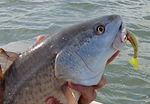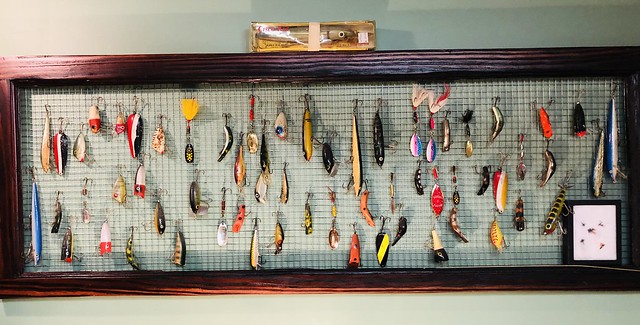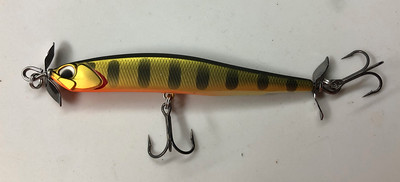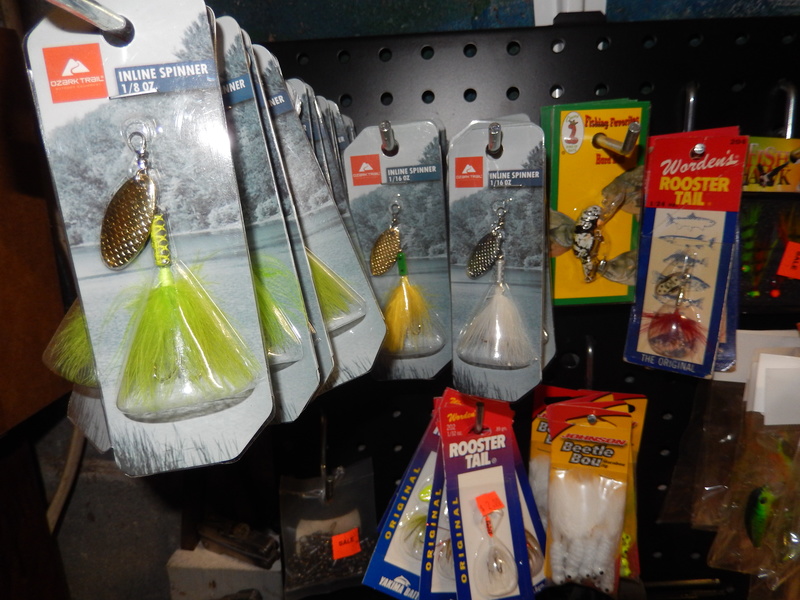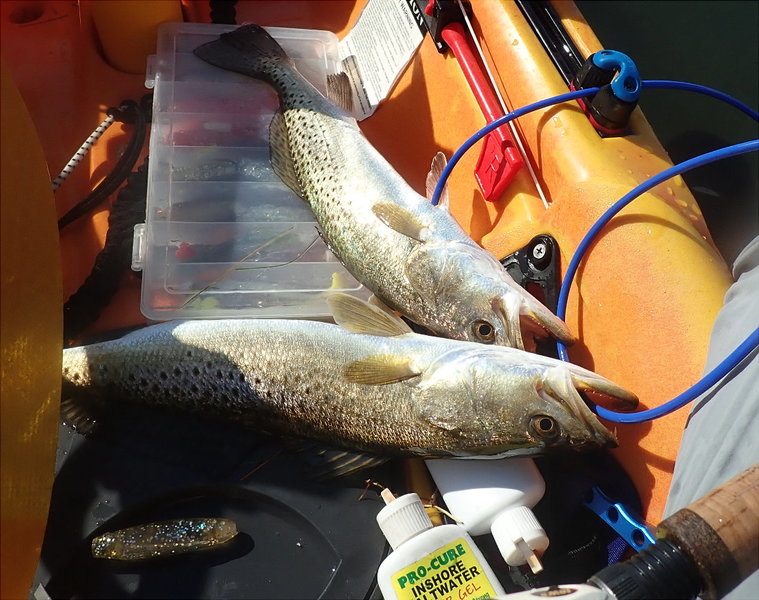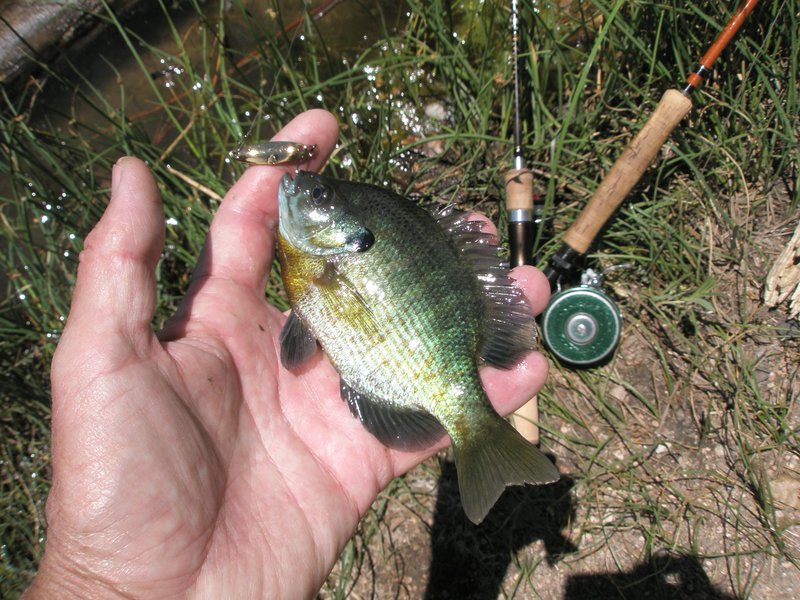We have a whole forum page dedicated to flies and fly tying, but I don't think we have a single 'Nother Spin thread on spin fishing lures (except maybe antiques). Pretty much all my spin fishing is inshore, but I grew up bass fishing reservoirs with my dad, fished jetties as a teenager and coast flats as an adult, took my daughters to hill country creeks, and keep a coldwater spin-tackle box for guests on the tailwater.
Growing up bass fishing reservoirs, two plugs took care of me - Jitterbug early morning, and Bomber on the deep slopes after the sun was taller.
My biggest bass as a teenager, 6-1/2 lbs, was caught on the Jitterbug - the lure sitting still was the tactic that drove her strike.
Inshore, we're imitating two main baitfish - mullet and glass minnows. Mullet evade side-to-side, make a continuous zig-zag just below the surface, and topwater dog-walking plugs at first light are most effective. Gave up the big jointed plugs in favor of YoZuri Pencil Lure, and, in fact, the Japanese have pretty much run away with most of the lure ideas. They also make a suspending version of this lure.


YoZuri has also run away with the Rapalas we grew up with.
Glass minnows inshore, as well as the cyprinids and poecellids we imitate in freshwater, school or "ball-up" for defense. Lures that attract bait are most effective - when the gamefish flares to eat, the bait school scatters, and your lure is what's left to eat.
My photo above is YoZuri Pins minnow. They make this in a floater-diver (also deep divers like Bomber), but their sinking version is one I find most effective. They offer a 2-3/4" 3/16th oz, and diminutive 2" 1/16 oz (the photo above shows the floater/diver and the 2-3/4" sinker).
Spoons have the advantage of casting out of sight, retrieved correctly, they flutter side-to-side like a swimming fish.
Growing up at the jetties, Johnson's Sprite and Daredevil spoons were the second most-effective lures.
A favorite of inshore wizards is Johnson's silver minnow in black nickel to imitate a crab. Crabs have a tail folded in their shell, they kick just like a shrimp to evade, then flutter down just like a falling spoon. They also walk sideways, holding up a claw to threaten, and the silver minnow spoon shape perfectly imitates that motion. Don't have a metal spoon photo, so borrowed one, but do have a couple of spoon flies - Mylar tubing + epoxy, and spun hair + epoxy. The latter is tough to throw on a fly rod, but perfect for UL - the thing is, when I'm wading that opportune water, I'll be fishing the fly rod.



On the right are Hogy's epoxy jigs, which are more accurately epoxy spoons and shine for casting into pelagics.
Spinners are great for casting and trolling, and very effective in river current. As a kid, my most effective reservoir trolling was using a hairpin tandem rig, Pico Texas Trailer, that fished a Bomber up front, and a Shyster spinner behind - occasionally ended up with doubles, and took my first 5-lb white bass. My first foray with a fly rod was 1/64th oz Panther-Martin spinners and 1/32nd oz Rooster Tails, aimed at white bass, endemic bass in limestone creeks, and bucketmouths in slow coastal plain rivers. That was how I fly fished until I began tying whistlers for white bass.
Here's that Guest tailwater spinning box, with home-made spinners, cats whiskers tied on weighted barbells, and soft plastic jigs.
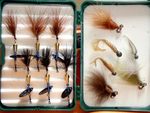
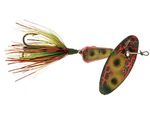
and borrowed the Warden's Vibric photo
Bucktail and marabou jigs combine the fly-tier's lure battery with a weighted hook. Marabou jig was the original bottom bouncing lure, and the fly rod analogy is cats whisker on a Teeny line. Inshore, the bait is killifish or "mud minnows." Jigs also suspend and fish vertically great. Now, many synthetic flash fibers and rubber are used in place of the natural materials.
Tandem jigs are very effective, and the store-packaged bucktail Spec Rig was that 1st most-effective jetty lure alluded above. My dad has caught every inshore double combination possible on these as his go-to lure. Because jigs look and behave so much like natural minnows, they're great at drawing those bait-balls also mentioned above.
Again, the best example I can throw up is a whistler fly, fished with intermediate or Teeny sinking lines, but fishes the same as a jig.


the original Spec Rig
A special lure combining spinner and jig is the hairpin crank bait, also Roadrunner, Beetle Spin, and buzz bait.
My favorite thing to fish on rare reservoir bass days is a buzz bait on my antique baitcasting tackle.
The original soft plastic bait was the Creme worm, and caught my share of bass with a sliding bullet weight. Then followed plastic grubs (fly rod analogy is a woolly booger) and those Burke's fly rod lures.
The original inshore soft plastics were Cococahoe minnow and Hogie's shrimp tails, and here's a couple of ways to rig those. Next, another view of those UL plastic jig bodies, the plastic-body tandem jig (TTF Super Shad rig) that's taken over Spec Rig's tandem crown.





and a Japanese krill lure
Since the advent of the swim shad, they've gone a long way with soft plastics, from krill to offshore ribbonfish.
With the clicking cigar cork rig above, I set up a neophyte buddy with a D.O.A. shrimp, and he caught a slot redfish trolling while he was paddling his kayak.
Storm Wildeye, Berkley Power, and Tsunami SS are all extremely effective swim shad, and tie-up killer tandem rigs.
Another invention in soft plastics is directional flash and color - they call these holographic, but they're simply a flat mylar foil in the middle of transparent plastic.
Here are a couple of great ones, Tsunami SS3, and Fish Arrow Flash J.
What I love about the Flash J is that transmitted light produces a different color, just like it would through live bait - the mylar reflects green and transmits purple-pink.



I took this photo of the same green-flash lure over a milk jug and bike headlight
Plastic lures have also gone another direction - neutral-density suspending lures - like fishing an intermediate sinking line (slime line) on a fly rod - but you can't dog-walk a fly rod...
On the left is my buddy Tobin's TSL grasswalker, the most amazing inshore lure I've ever fished - people also report bass, surf, and pelagic success.


On the right is the Texas-famous Corky, a hybrid suspending lure, inside a heavy plug (1/2- to 1-oz), outside a plastic balloon.
Apparently the Corkys name was lost in a partnership, and these are now sold by Mirrolure as the inventor, Paul Brown lures.
I intentionally left out poppers. I fished Hula-poppers and fly rod poppers, but I've found jitterbugs, dog-walkers and fly rod sliders or round dintys to be more effective on top than poppers.
























